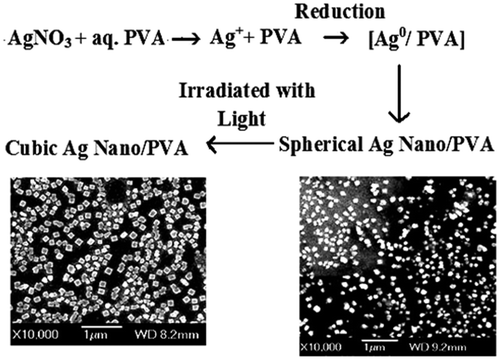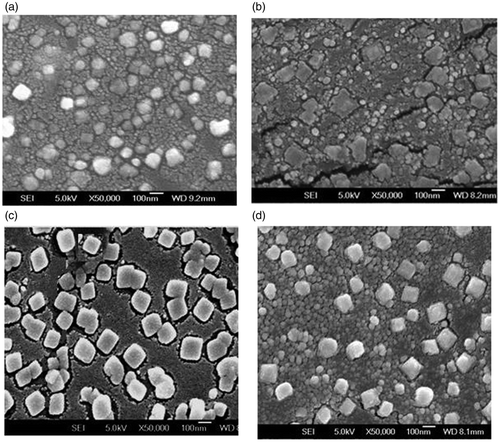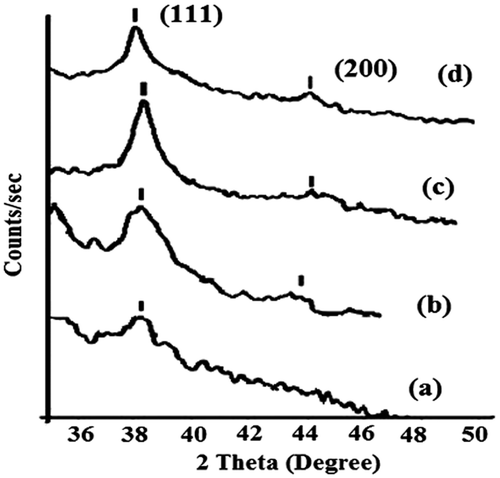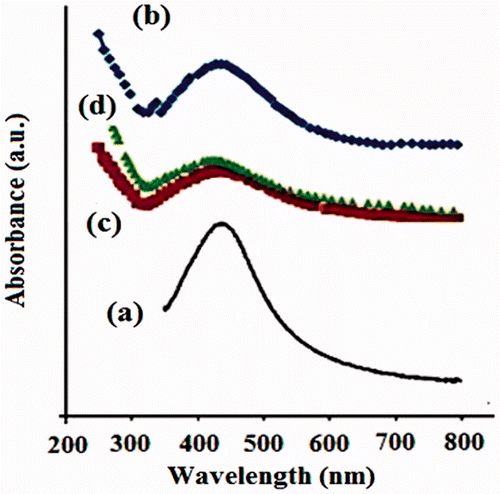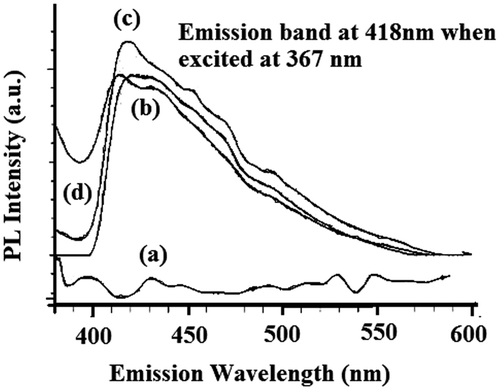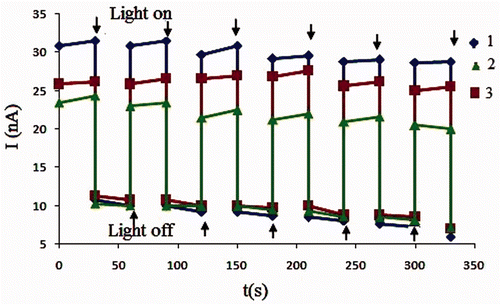Abstract
Silver nanocubes embedded in polyvinyl alcohol matrix have been synthesised by photoirradiation technique. The composite films are characterised by FESEM, XRD, UV-Visible absorption and photoluminescence. These show characteristics of silver nanoparticles with FESEM showing the cubic shape. The photoconductivity study of these films shows decrease in photocurrent with light irradiation. Such negative photoconductivity behaviour may be attributed to dominant scattering of electrons by excited surface plasmon polaritons in nanoscale.
1. Introduction
In metal nanostructures, interesting phenomena Citation1–3 are exhibited due to surface plasmon polariton (SPP) Citation4. Though SPP has capacity to have application potential in both photonics and microelctronics, most of the studies focussed on the optical properties Citation5–7. Relatively less attention has been paid to the transport properties. Amongst the metals, noble metal (Ag, Au, Pt) nano-sized particles have drawn much attention for their unique electrical and optical properties dependent on their size and shape Citation8–11. In most cases, silver nanoparticles can be obtained by reduction of silver nitrate. Also, to retain their nanosize, one often prepares nanocomposites by embedding the nanoparticles in glass Citation12, silica Citation13 or polymers Citation14–18 such as polyvinyl alcohol (PVA), polyacrilic acid or polymethyl methacrylate, etc. Out of these, PVA is used extensively as host matrix as it is water soluble, optically transparent and gives homogeneity to the silver nano dispersion. The existing methods to reduce silver nitrate in PVA matrix are numerous, to name some simple chemical reduction Citation19 microwave irradiation Citation20, polyol synthesis Citation21, sonochemical method Citation22 and photoreduction method Citation23,Citation24. Among these, the photoreduction method is widely adopted as one can easily obtain very stable nanocomposites by this method. Also, there are reports of obtaining special-shaped nanoparticles Citation24 other than spherical, with the help of this method. In this article, we explore optical transport (viz. photoconductivity) of cubic silver nano particles embedded in PVA along with their routine characterisation.
2. Experimental
2.1. Materials
Materials used for present fabrication process are PVA and silver nitrate. PVA (1700–1800 repeat units) is obtained from Sigma Chemical Co. and is of very high purity (99.9%). Silver nitrate of 99.9% purity is obtained from E. Merk, Germany. These materials are used without any further purification.
2.2. Method of synthesis and characterisation
Spherical-shaped silver nanoparticles are prepared by chemical reduction method Citation19. In PVA solution (3 wt%), silver nitrate (AgNO3) is added drop-wise with a continuous stirring for 1 h at 90°C. The colour of the solution turns to yellow indicating the formation of spherical-shaped silver nanoparticles. This transparent solution is then irradiated with light of wavelength of 475, 510 and 650 nm for 23 h. The colour of the solution becomes violet. This resultant solution is then spin cast on various substrates for further investigations. In , we show the scheme of subsequent stages of reduction of AgNO3 in PVA and change after the light irradiation.
Morphology and particle size determination of the composite film is done by field emission scanning electron microscope (FESEM) (JSM-6700 F, JEOL, Japan). Structural characterisation of the films are carried out by XRD (Scifert 3000 pd diffractometer) with Cu-Kα (0.15418 nm) radiation. Optical studies are done by UV-Visible (UV-Vis) absorption and photoluminescence (PL) studies which are carried by Cary 300 scan UV-Vis spectrophotometer and F-2500 FL spectrometer, respectively. The optical transport is studied by measuring photocurrent signal with time and also with applied voltage. The measurements are done by exciting with white light and measuring the photocurrent. For this purpose, CV meter (Keithley model 595) has been used both as voltage source and current measure.
3. Result and discussion
3.1. Morphology and formation mechanism
In , we show the FESEM pictures for the films for before irradiation (hereafter will be known as film 0) and three different irradiation wavelengths 475, 510 and 650 nm (hereafter will be known as film 1, 2 and 3, respectively), respectively. These show predominance of cubic structures of particle size ranging from 120 to 150 nm. However, this is larger than what we obtained for spherical-shaped Ag nano particles. Though we are not able to make significant correlation of these results with irradiation wavelength, one fact may be noted that for film 2, much homogeneously distributed particles of mostly cubic shape are obtained. Whereas in the other two films (1 and 3) there is a mixture of a larger number of smaller spherical clusters along with cubes.
3.2. Structural properties of silver nanocubes
The XRD patterns of the nano composite films is shown in . This shows a strong characteristic peak of silver nano around 2θ = 38° for (111) crystalline plane Citation25 and a less intense peak around 2θ = 44° for (200) crystalline plane. The broad nature of the XRD peak could be attributed to the nanosize of the particles. Here again for film 2, the (111) peak is sharper than those of the other two films with a possible indication of enhanced crystallinity compared to other two. This can be correlated with the SEM picture where mostly cubic larger number of silver nanoparticles are seen.
3.3. Optical properties of silver nanocubes
In , we show the UV-Vis absorption spectra of silver nano dispersed in PVA for four different films. This shows strong plasmon resonance peak nearly at 435 nm, which is a clear consequence of formation of nanosized particles Citation26. The absorption curves broaden more towards the red region indicating distribution of particle sizes of little wide range and the absorption peak corresponds to the value for average particle size. However, the profile is narrower for film 0 suggesting less variation in the particle size.
In , we show the room temperature PL of these four different films for excitation wavelength of 376 nm. These show emission band at 418 nm. In order to corroborate whether the PL emission is from the embedded Ag nanoparticles or from the parent compound (PVA), PL spectra for PVA film without silver nanoparticles is measured. The absence of an emission band at this region indicates that PL emission is originating from silver nanocubes. This result is similar to that obtained by Henglein et al. Citation27 for Ag nanoparticles reduced in the presence of polymers and Zheng et al. Citation28 for dendrimer-encapsulated silver nanodots. Also, with this particular excitation PL is insignificant for film 0.
In , we show current-voltage (I-V) characteristics (measurement at room temperature – 300 K) of dark as well as photo irradiated with white light. The I-V curves are linear upto applied voltage 20 V and the current value in the nA range though the dark current has higher magnitude than the irradiated one showing negative photoconductivity. This type of negative photoconductivity has been found in nanostructured sol–gel thin films of silver nanoparticles Citation29,Citation30.
Figure 6. (Colour online) I-V characteristics of the films 1, 2 and 3 before and after irradiation with white light.
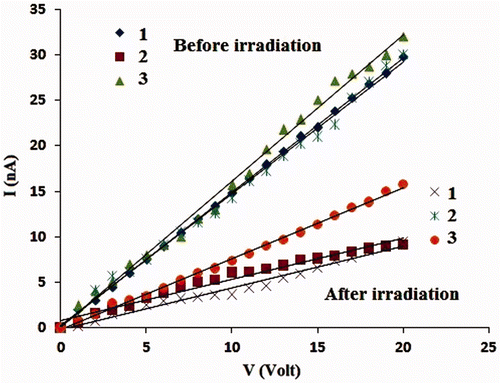
In , we show the kinetics of photocurrent with time of irradiation for different films. As the light source is switched on, the current decays instantaneously to less than half of its dark value and on switching off the light, it increased instantaneously again to reach the original dark value. So we are getting negative photoconductivity in these silver nanocubes. Similar type of negative conductivity has been obtained in silver nanowires Citation4 where such decrease in photocurrent has been attributed to dominant scattering due to SPP.
4. Conclusion
Silver/PVA nano composite nanocubes have been fabricated by simple photoreduction method using visible light. Silver nano formation is confirmed by UV-Vis. and XRD. FESEM pictures confirm nanocube formation in silver-PVA nano composite film with a wide range of particle size variation in the single film. This is manifested in the broadening of UV-Vis absorption spectra. We have also observed that the optical properties are better for nanocubes in comparison to their spherical counterparts giving stronger PL peak around 418 nm which is absent in silver nanospheres. For spherical nanoparticles, PL emission peak is obtained when excitation wavelength is more than 400 nm. Interesting optical transport feature, viz. negative photoconductivity shown in these materials even at room temperature (300 K) and using normal visible light.
Acknowledgements
The authors express their deep sense of gratitude to Dr M. Ghosh (IACS, Kolkata) for FESEM and XRD measurements and Dr P.K. Boruah (Department of Chemistry, Gauhati University, Guwahati) for PL measurements.
References
- Zhang , W , Govorov , AO and Bryant , GW . 2006 . Semiconductor-metal nanoparticle molecules: Hybrid excitons and the nonlinear Fano effect . Phys. Rev. Lett. , 97 ( 14 ) : 146804-1 – 146804-4 . doi: 10.1103/PhysRevLett.97.146804
- Kroner , M , Govorov , AO , Remi , S , Biedermann , B , Seidl , S , Badolato , A , Petroff , PM , Zhang , W , Barbour , R , Gerardot , BD , Warburton , RJ and Karrai , K . 2008 . The non-linear Fano effect . Nature , 451 ( 7176 ) : 311 – 314 . doi: 10.1038/nature06506
- Bliokh , KY , Bliokh , YP and Ferrando , A . Resonant plasmon-soliton interaction, Phys. Rev. A 79 (2009), pp. 041803-1–041803-4
- Sun , JL , Zang , Wu , Zhu , JL and Bao , Y . 2010 . Negative photoconductivity induced by surface plasmon polaritons in Ag nanowire macrobundles . Opt. Expr. , 18 ( 5 ) : 4066 – 4073 . doi: 10.1364/OE.18.004066
- Nie , S and Emory , SR . 1997 . Probing single molecules and single nanoparticles by surface-enhanced Raman scattering . Science , 275 ( 5303 ) : 1102 – 1106 . doi: 10.1126/science.275.5303.1102
- Kneipp , K , Wang , Y , Kneipp , H , Perelman , LT , Itzkan , I , Dasari , RR and Feld , MS . 1997 . Single molecule detection using surface-enhanced Raman scattering (SERS) . Phys. Rev. Lett. , 78 ( 9 ) : 1667 – 1670 . doi: 10.1103/PhysRevLett.78.1667
- H. Ditlbacher, A. Hohnau, D. Wanger, U. Kreibig, M. Rogers, F. Hofer, F.R. Aussenegg, and J.R. Krenn, Silver nanowires as surface plasmon resonators, Phys. Rev. Lett. 95 (2005), pp. 257403-1–257403-4
- Lepeshkin , NN , Schweinsberg , A , Pivedda , G , Bennink , RS and Boyd , RW . 2004 . Enhanced nonlinear optical response of one-dimensional metal-dielectric photonic crystals . Phys. Rev. Lett. , 93 : 123902-4 doi: 10.1103/PhysRevLett.93.123902
- Horiuchi , S , Fujita , T , Hayakawa , T and Nakao , Y . 2003 . Micropatterning of metal nanoparticles via UV photolithography . Adv. Mater. , 15 : 1449 – 1452 . doi: 10.1002/adma.200305270
- Kang , B and Wu , JW . 2006 . Fabrication of gold/polyvinyl alcohol nanocomposites by photoreduction and their optical characterization . J. Korean Phys. Soc. , 49 : 955 – 958 .
- Ng , KH , Lin , H and Pennon , RM . 2000 . Subnanometer silver clusters exhibiting unexpected electrochemical metastability on graphite . Langmuir , 16 : 4016 – 4023 . doi: 10.1021/la9914716
- Tokijabi , J , Nabamura , A , Kanebo , S , Ucchuda , K , Onis , S , Taji , H and Asabana , Y . 1994 . Subpicosecond time response of third-order optical nonlinearity of small copper particles in glass . Appl. Phys. Lett., , 65 : 941 – 943 . doi: 10.1063/1.112155
- Tanahashi , I and Mitsuyn , T . 1995 . Preparation and optical properties of silica gels in which small gold particles were grown by photoreduction . J. Non-Cryst. Solids, , 181 : 77 – 82 . doi: 10.1016/0022-3093(94)00498-6
- Mbhele , ZM , Sakmane , MG , Van Sittert , CGCE , Nedeljkovic , JM , Djokovic , V and Luyt , AS . 2003 . Fabrication and characterization of silver-polyvinyl alcohol nanocomposites . Chem. Mater. , 15 : 5019 – 5024 . doi: 10.1021/cm034505a
- Zeng , R , Rong , MG , Zhang , MQ , Liang , HC and Zeng , HM . 2002 . Laser ablation of polymer based silver nanocomposites . Appl. Surf. Sci. , 187 : 239 – 247 . doi: 10.1016/S0169-4332(01)00991-6
- Zhang , Z and Han , M . 2003 . One-step preparation of size-selected and well-dispersed silver nanocrystals in polyacrylonitrile by simultaneous reduction and polymerization . J. Mater. Commun. , 13 : 641 – 643 . doi: 10.1039/b212428a
- Liu , H , Ge , X , Zhu , Y , Xu , X , Zhang , Z and Zhan , M . 2000 . Synthesis and characterization of polyacrylamide-nickel amorphous nanocomposites by γ-irradiation . Mater. Lett. , 46 : 205 – 208 . doi: 10.1016/S0167-577X(00)00170-1
- Firth , AV , Haggata , SW , Khanna , PK , Williams , SJ , Allen , JW , Magennis , SW , Samuel , IDW and cole-Hamilton , DJ . 2004 . Production and luminescent properties of CdSe and CdS nanoparticle-polymer composites . J. Lumin. , 109 : 163 – 172 .
- Deb , S and Sarkar , D . 2008 . Fabrication of silver/cross-linked polyvinyl alcohol nanoparticles by hydrothermal method . Indian J. Phys. , 82 ( 6 ) : 715 – 718 .
- Tu , WX and Liu , HF . 2000 . Continuous synthesis of colloidal metal nanoclusters by microwave irradiation . Chem. Mater. , 12 : 564 – 567 . doi: 10.1021/cm990637l
- Silvert , PY , Herra-Urbina , R , Duvau Chelle , N , Vijayakrishnan , V and Tekaia-Elhsissen , K . 1997 . Preparation of colloidal silver dispersions by the polyol process . J. Mater. Chem. , 7 : 293 – 299 . doi: 10.1039/a605347e
- Mizukoshi , Y , Oshima , R , Maeda , Y and Nagata , Y . 1999 . Preparation of platinum nanoparticles by sonochemical reduction of the Pt(II) ion . Langmuir , 15 : 2733 – 2737 . doi: 10.1021/la9812121
- Kamat , PV . 2002 . Photophysical, photochemical and photocatalytic aspects of metal nanoparticles . J. Phys. Chem. B , 106 : 7729 – 7724 . doi: 10.1021/jp0209289
- Zhou , Y , Wang , CY , Zhu , YR and Chen , ZY . 1999 . A novel ultraviolet irradiation technique for shape-controlled synthesis of gold nanoparticles at room temperature . Chem. Mater. , 11 : 2310 – 2312 . doi: 10.1021/cm990315h
- Aanita , S , Selvakannan , PR , Renu , P and Murali , S . 2004 . One-step synthesis of ordered two-dimensional assemblies of silver nanoparticles by the spontaneous reduction of silver ions by pentadecylphenol Langmuir monolayers . J. Phys. Chem. B , 108 : 19269 – 19275 . doi: 10.1021/jp0465581
- He , R , Qian , X , Yin , J and Zhu , ZK . 2002 . Preparation of polychrome silver nanoparticles in different solvents . J. Mater. Chem. , 12 : 3783 – 3786 . doi: 10.1039/b205214h
- Henglein , A , Linnert , T and Mulvaney , P . 1990 . Reduction of Ag+ in aqueous polyanion solution: Some properties and reactions of long-lived oligometric silver clusters and metallic silver particles . Ber. der Bunsen-Gesellschaft , 94 : 1449 – 1457 .
- Zheng , J and Dickson , RM . 2002 . Individual water-soluble dendrimer-encapsulated silver nanodot fluorescence . J. Am. Chem. Soc. , 124 : 13982 – 13983 . doi: 10.1021/ja028282l
- Garcia , J , Franco , A , Valverde , G and Zink , JI . 2004 . Photoconductivity on nanostructured sol-gel thin films with silver nanoparticles . Proc. SPIE , 5520 : 206 – 215 . doi: 10.1117/12.559688
- Garcia , J , Franco , A , Valverde , G , Lockard , J and Zink , JI . 2004 . SERS on mesostructured thin films with silver Nanoparticles . Proc. SPIE , 5361 : 117 – 124 . doi: 10.1117/12.529756

